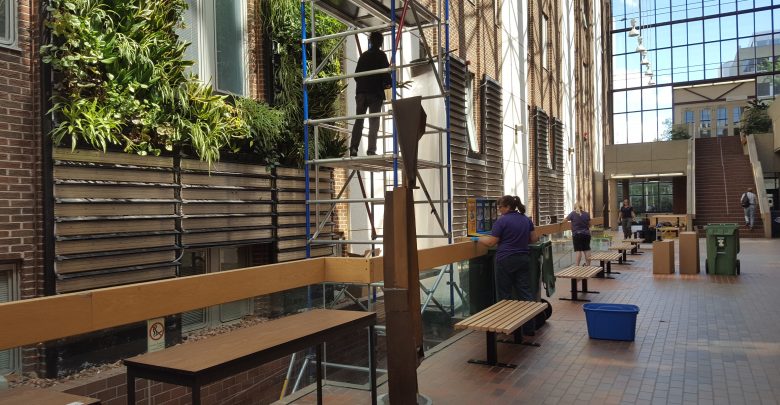 Richard Bagan
Richard BaganThe living wall in Tory Atrium has been dismantled due to a lack of funding to manage the “ballooning” cost of pest control. Although I hate mice as much as the next person, I’m also crushed. The wall’s dismantling was an unnecessary and shortsighted step on the part of the University in its attempt to save money.
Those of us in the social sciences and humanities who take many (if not all!) of our classes in Tory were the first to complain. A lack of windows, overabundance of the colour grey, scarcity of functional water fountains, and usually-disgusting, over-crowded bathrooms designate Tory as one of the most depressing buildings on campus. Last winter, I spent two days a week cramped inside Tory classrooms filled with mismatched reject desks from the 1990s for four and a half straight hours. Needless to say, it was the most grueling semester I’ve experienced to date.
The living wall, however, was a shining beacon of hope. It reminded us that the colour green exists while we spent the month of March spending 18 hours a day in class or studying, periodically moving from classroom to library without ever actually going outside. It brought a piece of spring to the university during Edmonton’s long, cold winters. It was a sign that the university was actually willing to invest in our happiness!
I could endlessly wax poetic about the living wall; however, from a more factual perspective, living walls bring many tangible benefits through creating pleasant, sustainable spaces. Not only do they improve air quality, but they help to reduce noise levels and boost morale, two effects which are particularly useful in Tory. The Atrium is often loud, and Arts students often need their morale boosted. Enough said.
Although the cost of mouse control is obviously a barrier to the maintenance of the living wall, I wonder if this decision can be at least partly attributed to poor funds management, a problem for which the University of Alberta is becoming somewhat infamous.
Removing the living wall entirely was not the only solution to the “pest problem.” Herbs like mint and lavender repel mice and could’ve been planted alongside more ornamental plants to mitigate the problem in a natural and affordable manner. As well, the fact that mice could access the living wall is indicative of a more serious pest problem that the University will likely need to address anyway. Removing the wall treats the symptom without curing the disease.
Living walls can also help reduce energy costs, making them not only sustainable but also financially beneficial. They can also increase property value because of their aesthetic appeal. Although the cost of pest control may have been high, there could’ve been long-term financial benefits to maintaining the living wall.
A consultative process to replace the living wall with another aesthetically pleasing installation is set to begin in Fall 2018 when most students return to classes. Hopefully, this pans out, although the University isn’t exactly well-known for communicating with its students (new BA, anyone?).
To add insult to injury, the plants weren’t repurposed or moved to a more suitable location. Workers who were removing them said that due to the way they were cared for, the plants couldn’t be transplanted and had to be thrown away. Unfortunately, until the University’s “consultative process” is complete—and who knows when that will be—Tory Atrium will be just as drab as Tory itself.




